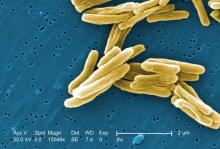A new approach to screening has improved detection of tuberculosis among people applying to move to the United States, according to a report published online March 17 in Annals of Internal Medicine.
The previous preimmigration screening process involved chest radiography and, for those with abnormal radiographs, acid-fast bacilli smears of three consecutive sputum samples. If at least one smear was positive, the patient completed TB treatment overseas and was followed up after arrival in the United States. This approach failed, however, to detect some latent cases of TB that became reactivated soon after immigrants arrived in the United States.
The new screening process also includes Mycobacterium tuberculosis culture results. For those who have at least one positive sputum smear or culture result, drug-susceptibility testing is performed and directly observed therapy for TB is typically completed overseas before U.S. relocation is allowed, Yecai Liu, a mathematical statistician with the division of global migration and quarantine, Centers for Disease Control and Prevention, and his associates said.
To assess the effectiveness of the new screening algorithm, the researchers analyzed information in the CDC’s disease notification database and the Department of Homeland Security’s immigration records regarding 3,212,421 immigrants and refugees who were screened overseas and arrived in the U.S. during a 7-year period. A total of 51.4% were screened by the old method and 48.6% by the new method.
Before the new screen was implemented, the annual number of smear-negative TB cases among newly arrived immigrants and refugees was relatively constant, at approximately 1,500/year. That number dropped to 940 cases/year after the new screening method was implemented. At the same time, the number of smear-negative but culture-positive TB cases diagnosed overseas among people bound for the U.S. increased from 4 to 629 cases per year.
Thus, the cumulative decline in U.S. cases during the study period was similar to the cumulative total of cases detected before relocation, the investigators said (Ann. Intern. Med. 2015 March 17 [doi:10.7326/M14-2082]).
The findings indicate the new culture-based TB screening is superior to smear-based TB screening and is “a high-yield intervention for preventing TB in immigrants and refugees bound for the United States.” Expanding such screening to cover exchange students, other exchange visitors, and temporary workers from countries with a high incidence of TB might further reduce the rate of the disease in foreign-born populations, the researchers concluded.


